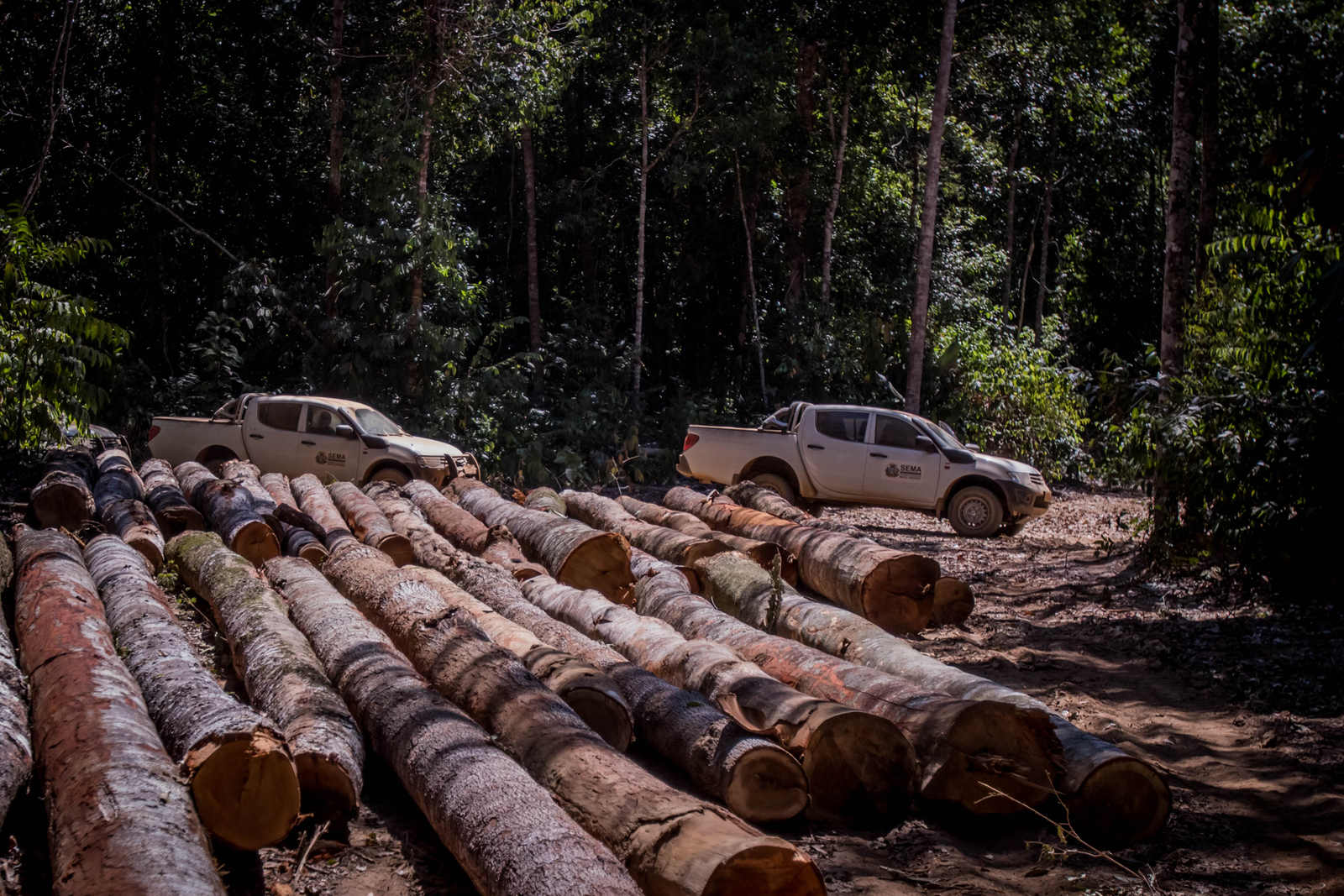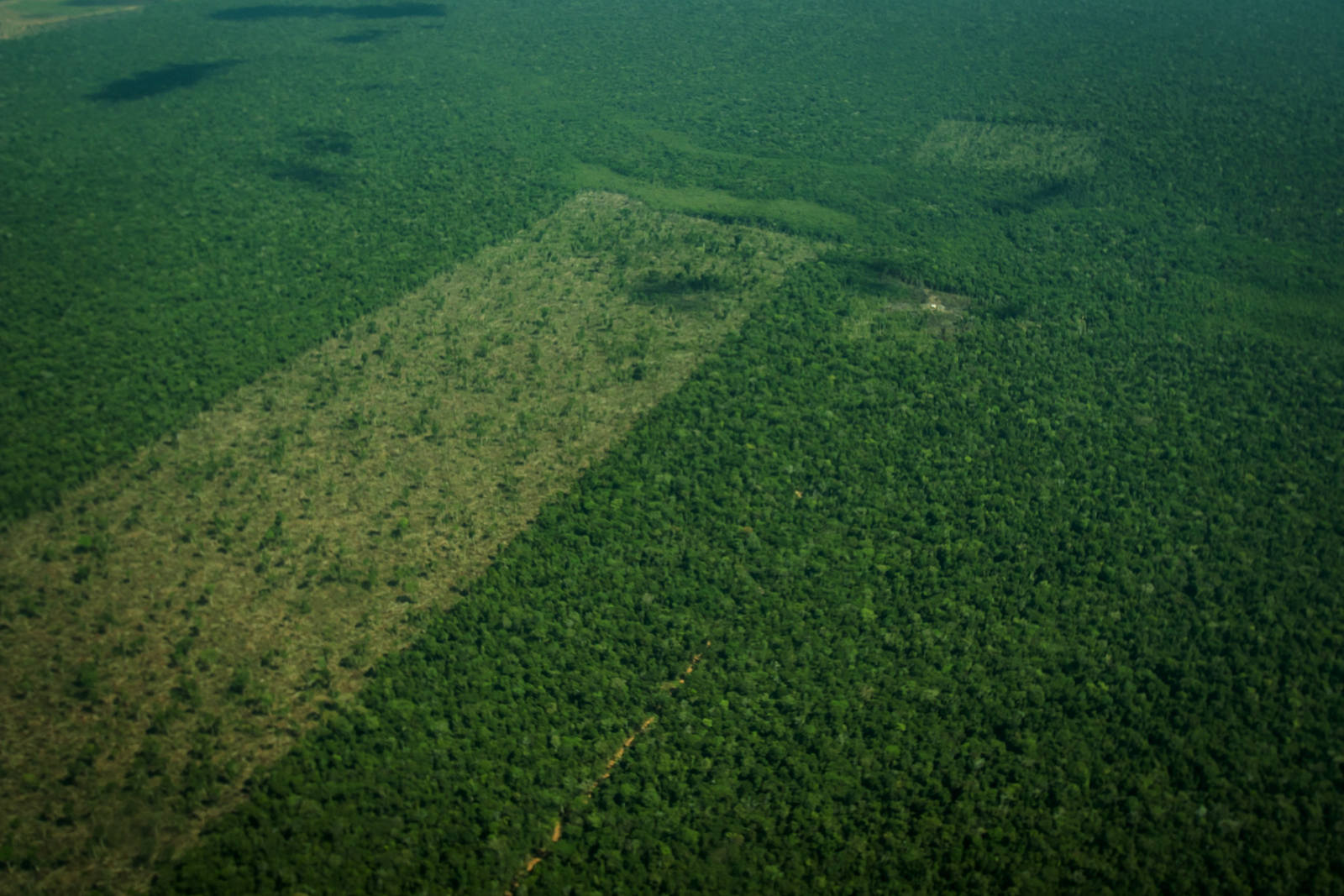The official crests of the towns of Marcelândia and Feliz Natal, in northern Mato Grosso, display three fallen logs and an ox, respectively. Deforestation, logging, and livestock are also ubiquitous in daily life and are related to the recent high rates of devastation in the two municipalities, both in terms of hot spots and deforested area. Located near the boundaries of the Xingu Indigenous Park, in a region known for ‘new areas’ of deforestation, these cities epitomize the escalation of Amazon environmental degradation in the state and help prevent Mato Grosso from reaching zero illegal deforestation by 2020 – a target the state set in 2015.
Inpe (Brazil’s National Institute for Space Research) recorded 162 fires in Feliz Natal between June and July this year – the highest figure among municipalities of the Amazon biome in Mato Grosso – while Marcelândia had the largest deforested area (83 km²) among registered rural properties, according to Prodes data from 2018-2019. And these are just two pieces of information showing how the situation in those towns illustrates the state’s failure to end illegal deforestation – a promise made during the Climate Summit in Paris that is becoming increasingly unreachable.
Between August 2019 and July this year, Inpe detected 1,800 square kilometres of deforested area in Mato Grosso’s Amazon biome – an increase of 31 percent over a year earlier and 60 percent compared to two cycles ago (August 2017 to July 2018). Monthly escalation of degradation was also dramatic and was more intense precisely last July, with the rate of deforestation increasing by 136 percent over the previous month.

One of the Mato Grosso government’s main measures to curb forest destruction within that period was investing in modern monitoring satellite systems. At the cost of R$ 6 million, the Planet alert system was hired in 2019 with funds received by the state from the UK and Germany. Another initiative to meet the target – in partnership with the Public Prosecution Service – was to cross Planet data with information on areas listed on Brazil’s Rural Environmental Register (CAR) to improve environmental violation reports.
However, these measures were neutralized by three mistakes, according to experts. Projections and promises were not realistic; there was a lack of political work against the actions of the federal government that make it difficult to control deforestation; and, finally, practical actions were shy since remote monitoring of fire and deforestation is not enough, even when it uses cutting-edge satellites.
Asked by Repórter Brasil about the situation, the Mato Grosso government recognized that “the deficit in investments necessary to leverage sustainable development in the state is still very high.” But it stated that, for this to happen, there must also be “collective action that includes other spheres of public administration and involves the private sector and civil society” (read the answer in full here).

Fernando Sampaio, executive director of the government’s strategy towards zero deforestation – called Producing, Conserving and Including – admits that the state target “is very far” from being met. “Ruralists say that Brazil can produce a lot more without deforestation. But the fact is that, even if we improve environmental inspections to try to halt [devastation], this game ca only be turned by ascribing real value to the standing forest”.
The town of Feliz Natal once again illustrates Sampaio’s statement about how intact forest is worth much less than devastated areas. For tax collection purposes, the municipal government set the value of each hectare of preserved area at R$ 1,480, while farming land is worth three times more: R$ 4,433. Even for areas considered ordinary for farming, the amount is set at R$ 3,614. “To this day, standing forest is still worthless. For anyone who owns a forest area, land is worth much more without a forest than with it,” Sampaio stresses.
‘Dramatic’ deforestation and record livestock production
“The numbers are terrible. The amount of deforestation is dramatic due to the loss of biodiversity that Brazil is undergoing,” says prosecutor Marcelo Vacchiano, head of the Technical Centre for Support to Environmental Execution of the Mato Grosso State Prosecution Service (MPMT).
Alice Thuault, deputy director of Centro de Vida Institute (ICV), also sees the figures on escalating deforestation as ‘scary’ and she criticizes the ‘anti-environmental show’ put on by the federal government that dominated the sector’s agenda. In the same survey that shows that 85 percent of deforestation in Mato Grosso in 2018/2019 was illegal, the fall in the number of Ibama’s fines for damages to the state’s flora was also stressed: from 1,093 in 2015 to just 411 in 2019 – less than half in a year of more environmental devastation.
Ibama is under ‘military intervention,’ especially since the executive order on Guarantee of Law and Order (GLO) and the creation of Operation Verde Brasil 2 in May, which has been dismantling state policies by replacing experienced technical staff with military officers.
According to Prosecutor Vacchiano, this government agenda that does not address the country’s socio-environmental problems also includes pardon for environmental crimes, inertia before forest invasions and land grabbing, and instructions from Minister of the Environment Ricardo Salles to ‘pass the cattle through the gate’ on legal deregulation (meaning to approve it in batches).

At state level, civil society organizations also criticize the approval by the Mato Grosso State Parliament of a bill that allows clearing native forest in Permanent Protection Areas (PPA) for self-declared ‘low impact’ projects without properly checking properties’ environmental registration and opening the way for ‘express’ licensing based only on documentation submitted by interested parties. In its original version, the project even authorized registering properties that overlap Indigenous Lands still in process of approval – an item that ended up being removed from the text approved in July, in the middle of the pandemic, after pressure from Indigenous Peoples and environmentalists.
This scenario of environmental weakness takes place in a context of extremely high agribusiness production. The Gross Value of Agricultural Production (VBP) in Mato Grosso is expected to reach R$ 125 billion in 2020, according to the Ministry of Agriculture. It is the highest in the country (17.5%), followed by the states of Paraná (12.8%), with R$ 91 billion, and São Paulo (12.7%), with R$ 90.7 billion. This year, the national gross value is expected to reach R$ 716 billion – an 8.8 percent increase over 2019. Driven by record grain harvests and higher prices for agricultural products, it will be the largest production in 31 years – even amid the Covid-19 pandemic and with several industries undergoing retraction.
The municipal level
Both the figures and the government measures in its actions aimed at environmental dismantling are part of Marcelândia’s recent history. Located 210 km from Sinop, the hub of Mato Grosso’s so-called ‘Big North’ region between the BR-163 Highway and the Xingu Indigenous Park, Marcelândia was the target of Ibama and the National Force operations – such as Curupira (2005) and to Arco de Fogo (2008) – which found irregularities and shook the local timber industry.
After remaining on the list of priority towns for the Ministry of the Environment’s actions for prevention, monitoring and control between 2008 and 2013, Marcelândia spent five years in the group of municipalities where deforestation was monitored and under control – only to return to the list of places demanding high attention in 2018. Only one person linked to an agribusiness company is being charged in the package of investigations conducted by the Public Prosecution Service for the illegal deforestation of 2,900 hectares in that town (corresponding to almost 3,000 football fields) in 2008-2019. Another landowner, a businessman who lives far away in a southern Brazilian town where he used to be the mayor, is charged by the Prosecution Service for illegally clearing another 1,000 hectares in the same period.
Large properties prevail in the municipality – areas under 400 hectares are only 5% while farms with more than 2,000 hectares cover 71 percent – which indicates that, in general, those who deforest and burn in Marcelândia are not family farmers, settlers or community members. They are big farmers.
According to head of the Municipal Environmental Department Suzana Barbosa, “Marcelândia is undergoing a process of transition from livestock to agriculture, with turnover in landowners, something that did not use to happen often. We observe that some of them arrive here, do their ‘cleaning up’, ‘clear their land’ and then go on to ‘burn.’ Sometimes they ignore inspections altogether.”
According to her, the frequency of environmental inspections was reduced: “Between 2013 and 2018, Ibama inspectors used to arrive here as soon as the rainy season ended (between February and April) and stayed until November or December.” In 2019 and 2020, operations were scarce, according to Barbosa, with only occasional remote monitoring interventions, and they did not last more than 20 days.
Last year, forest fires recorded by the Fire Department in Marcelândia scared the population, who remembered the inferno of the 2010 fire season – when flames advanced over the town area, leaving families homeless, destroying 80% of companies, and creating the need for an emergency decree.
Even so, Marcelândia still comes third in the Amazon biome in Mato Grosso in number of hot spots (148) detected by Inpe between June and July 2020, just behind neighbouring Feliz Natal (162) and Gaúcha do Norte (152).


